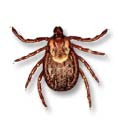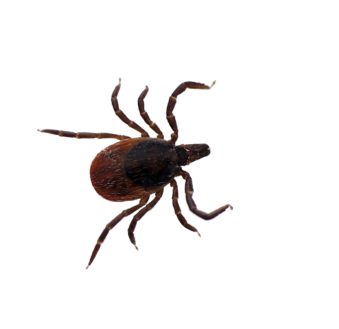Of increasing concern in our area is the tick population. There are a lot of common misconceptions about the nature and behavior of ticks, and what people can do about them. This post aims to address some of those concerns, and educate you about how to protect yourself, your family, and your pets from them. It will also (hopefully) educate you about the risks of disease associated with tick bites. Keep reading for more about tick control in Lancaster and Harrisburg.
Myths and Misconceptions
As a professional pest control company, we often get questions from clients about ticks. One of the most common questions we’ve gotten over the last couple of years have been about tick control; how to protect people and pets.
First and foremost, you need to understand some things about tick behavior and biology that will help you better arm yourself against this threat: ticks do not jump onto people, at least not in the way that fleas do. Often clients think that fleas and ticks are both these long-jumping, blood-sucking nuisances. That’s only half true; they both seek bloodmeals.
However, ticks are far less mobile than fleas. They often hang onto plant material, and stick their two front legs out in the air. Entomologist’s have labeled this behavior as “questing” – the tick is trying to go on a journey! Those two front legs have little “hooks” on them if you will, and when an animal or person brushes against the plant they’re on, the front legs snag on, like Velcro. That’s how the tick “hitchhikes” to its next destination or its next meal.
The reason so many people believe they jump like fleas is largely due to the way pet treatment products are marketed – namely as “flea and tick” products. Many people assume that the products work because the pests behave the same way. This is untrue; the products work because they are targeting the pest’s food source.
Types of Ticks
The four common ticks found in Pennsylvania are: the American Dog Tick, the Blacklegged Tick, the Lone Star Tick, and the Groundhog Tick. Groundhog ticks are a vector (read: carrier) for Lyme’s Disease, as are blacklegged ticks. Groundhog ticks are largely found in Western Pennsylvania; therefore, we’ll focus on the other three species.
Lone Star Ticks
Lone Star ticks are easily identifiable. They are brown in color and have a large whitish dot on their backs. Their native range is mostly in the Midwest, but they have been found in recent years in counties in Southern Pennsylvania. You are most likely to encounter these ticks here in South Central PA in an urban area.
 American Dog Tick
American Dog Tick
American dog ticks are found all up and down the east coast of North America, from Canadian provinces all the way to states on the coast of the Gulf of Mexico. This is by far the most commonly encountered tick in Pennsylvania. American dog ticks are identifiable by their mottled brown appearance.
Blacklegged (Deer) Ticks

Black legged deer tick isolated – Ixodes scapularis
Blacklegged ticks are also incredibly common here in Lancaster, Lebanon, Dauphin, Berks, York, and Cumberland Counties. We live and operate our business in a part of the state that is considered to have a “heavy infestation” of blacklegged ticks. They are usually dark brown, with a large black spot on their backs, near the head, and of course have black legs.
Diseases
There are a whole host of diseases that ticks can carry and transmit to humans, and in some cases pets. Here are a few of the most common or most dangerous ailments you should be concerned about…
Lyme’s Disease
This is the most commonly known tick-borne disease. The first sign of Lyme’s disease is usually a bulls-eye rash around the bite site. Symptoms can range from flu-like symptoms to swelling of the joints and extreme fatigue.
Most patients recover fully with antibiotic treatments. In extreme cases, a doctor may prescribe pain medication to help alleviate symptoms.
Carriers for this are the blacklegged tick and the groundhog tick.
Powassan Virus
This virus is named for the town of Powassan, Ontario, because it was first identified in a young boy living there who eventually died from complications. Symptoms show up between a week and a month after transmission of the virus and include fever, nausea, and vomiting. Symptoms may progress and become more serious, including memory loss or confusion and even seizures.
There is no specific treatment for Powassan virus, according to the CDC , and patients often need to be hospitalized and receive breathing support, medication to reduce brain swelling, and IV fluids to prevent dehydration.
Carrier for this is the blacklegged (deer) tick.
Rocky Mountain Spotted Fever (RMSF)
Rocky Mountain Spotted Fever was first diagnosed, as the name implies, in people who spent time in the forests of the Rocky Mountains. By the early 1960’s, over 90% of the cases in the U.S. were reported east of the Mississippi River. Symptoms include bruising around the wrists and ankles. Fever, headaches, and a general sort of “malaise” are other symptoms.
Treatment for Rocky Mountain Spotted Fever includes a course of antibiotics.
Carriers for this are the Lone Star tick and the American dog tick.
Prevention and Personal Precautions
These are common-sense measures, really. If you’re an avid outdoors-person, you really should do a few things to protect yourself.
- Wear long sleeves.
- Wear light colored clothing, and check if frequently for the dark-colored ticks.
- Long pants, with long socks, are a must. Tuck the pant bottoms into the socks for best protection.
- Use bug spray. Your best bet is a bug spray with no more than 35% DEET, or a permethrin applied ONLY to your clothing because permethrin isn’t labelled for use on human skin like DEET.
- Check your person and people travelling with you regularly to make sure you don’t have any of these “hitchhikers.”
For pets, you should use a topical treatment that is applied at regular intervals (i.e. monthly). Be diligent about both the application and checking your pet’s coat regularly once they’ve re-entered the home after being outside.
For more information about our treatment services for your property that help reduce both tick and mosquito populations, we’d love to talk with you. Please contact our office.

